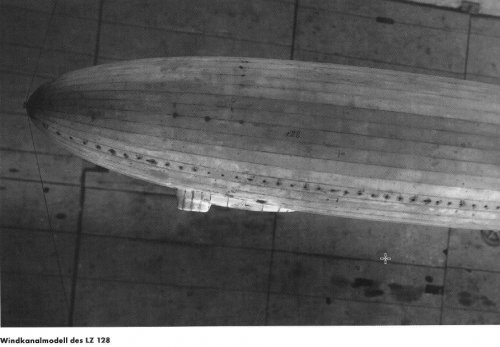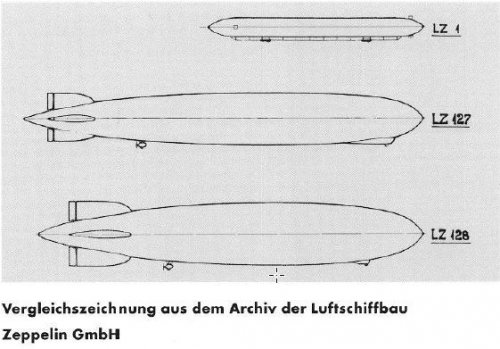Real data about LZ 128 seem to be quite scarce, what I found is from "Luftschiffe, die nie gebaut wurden", Zeppelinmuseum Friedrichshafen.
LZ 128 should have had a volume of 155,000 cbm. In the mentioned book it is said, that the comparative drawing gives contradictory data for
length and diameter. Length probably would have been 233,5m, diamter 38,74m. Four engine cars were planned, each with 2 Maybach VL2
engine in a push/pill arrangement.
LZ 131 was a development of the previous class with an overall length of 263m, axed in 1940
According to Luftschiffbau Zeppelin records, LZ-128 never made it past early design concepts before the project was scrapped, as the ship would have been a near identical clone of the LZ-127 Graf Zeppelin, which was by that time, had become somewhat antiquated providing passengers rather spartan accommodations in return for their booking fare - $400 for a one way flight or $720 for a return flight trip. For perspective, that $400 passage in 1936 would be a $7,448.52 passage today, while the $720 return flight would be $13,407.34.
LZ opted instead to go with a clean sheet design, the LZ-129 Hindenburg and LZ-130 Graf Zeppelin.
As Andrewjs2007 stated, work had just got underway on the LZ-131, IIRC, only one complete hull ring had been assembled by April of 1940, when Hermann Goring issued the orders to scrap the LZ-127 and LZ-130.
Former LZ/DZR Captain Max Pruss, with several other notable former LZ employees, and with the blessing of Dr. Hugo Eckener, began formulating ideas on how to revive the transatlantic passenger airship service of the postwar era.
After an investor expressed interest in placing an order for a new airship should he agree to finance the founding of the new venture, an expert commission was founded that began work on a feasibility study on September 1, 1956. Max Pruss similarly began work on engineering drawings for the LZ-132 that would be constructed should the deal go through.
In terms of technology, LZ 132 would have built on the unfinished
LZ 131, which itself would have been a near carbon copy of the LZ-130, only difference being the passenger capacity. The key data were a volume of 223,000 m³ of helium, a diameter of 41.7 m and a length of 265 m.
With engines installed inside the hull driving the propellers via geared output shafts, like the two Goodyear-Zeppelin built ZRS ships operated by the US Navy, a top speed of 120 to 147 km/h was expected.
Two possible business areas were targeted for passenger and freight service: Firstly, the transport of passengers to North and South America - 100 passengers for the North American trips, 70 for the South American trips, and secondly, its use as a flying freighter, with a total estimated cargo capacity of up to 30 t.
After the presentation of an interim report at the end of February 1957, the final version of the feasibility study was completed on June 24, 1957. The study, along with Pruss' blueprints for the new prospective airship were presented to the potential investor in late September of 1957, who after reviewing them, ultimately decided to decline the deal as being economically non-viable. Ultimately, LZ 132 never made it beyond Pruss' initial conception blueprints.



